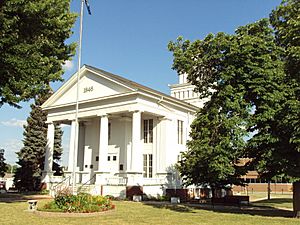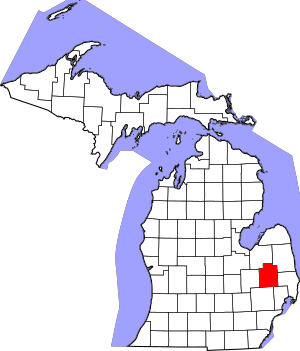Lapeer County, Michigan facts for kids
Quick facts for kids
Lapeer County
|
|
|---|---|

|
|

Location within the U.S. state of Michigan
|
|
 Michigan's location within the U.S. |
|
| Country | |
| State | |
| Founded | September 18, 1822 (created) February 2, 1835 (organized) |
| Seat | Lapeer |
| Largest city | Lapeer |
| Area | |
| • Total | 663 sq mi (1,720 km2) |
| • Land | 643 sq mi (1,670 km2) |
| • Water | 20 sq mi (50 km2) 3.0%% |
| Population
(2020)
|
|
| • Total | 88,619 |
| • Density | 137/sq mi (53/km2) |
| Time zone | UTC−5 (Eastern) |
| • Summer (DST) | UTC−4 (EDT) |
| Congressional district | 10th |
Lapeer County is a county located in the U.S. state of Michigan. As of the 2020 Census, the population was 88,619. The county seat is Lapeer. The county was created on September 18, 1822, and was fully organized on February 2, 1835. The name is a corruption of the French la pierre, which means "the stone". Lapeer County is included in the Detroit-Warren-Dearborn, MI Metropolitan Statistical Area.
Contents
History
Lapeer County was part of New France from 1534, and as New France gained in population, part of the Pays d'en Haut (upper countries) dependency of the Colony of Canada from its formation as a department of New France in 1712. In 1763 England took possession, then renamed the colony and its dependencies the Province of Quebec. France and England controlled trading by establishing forts to settle disputes and enforce laws, utilizing ancient overland and waterborne trade routes, while providing superior tools and weapons in exchange for valuable furs
Following the American Revolution, Great Britain ceded portions of the Province of Quebec to the United States of America. By an ordinance of the Congress of the United States passed in July 13, 1787, under the Articles of Confederation, the whole of the territory of the United States lying northwest of the Ohio River, though still occupied by the British, was organized as the Northwest Territory. The area that is now Lapeer County used to be a part of the County of Wayne, named in the honor of General Anthony Wayne. This original Wayne County was created on August 11, 1796, and included all of the lower peninsula of Michigan, parts of Northern Ohio and Indiana, and also portions of Wisconsin and Illinois.
What is now Lapeer County, on May 7, 1800, became part of the Territory of Indiana, which included all of the lower peninsula of Michigan. After Ohio and Indiana became states, the Territory of Michigan was formed. In 1807 local Indian tribes ceded the land of Southeast Michigan in the Treaty of Detroit. In January, 1820, the County of Oakland was formed. On September 18, 1822, Governor Lewis Cass set Lapeer County's boundaries, although it remained a part of Oakland County until it was organized; Lapeer County officially became a county on February 2, 1835. The first recorded elections for county officers, with 520 people voting, occurred in 1837.
The first settler in Lapeer was Alvin N. Hart, who was born in Cornwall, Connecticut on February 11, 1804. He came to Lapeer in 1831 and platted the Village of Lapeer on November 8, 1833. The plat was registered in Pontiac, December 14, 1833, in Oakland County's Associate Judge Bagley's Court. Alvin Hart became a state senator in 1843, representing Lapeer, Oakland, Genesee, Shiawassee, Tuscola, Saginaw counties and the entire Upper Peninsula. He was instrumental in having the state capitol moved from Detroit to Lansing.
Lumber was the principal industry of the Lapeer County area from the 1830s until 1870, with the expectation that the removal of much of the county's forests would attract farmers as settlers. Lapeer's economy shifted to become primarily agriculturally based. On October 26, 2010, Lapeer became a founding member of the Karegnondi Water Authority.
Historical markers
There are 15 historical markers throughout Lapeer County:
- Columbiaville Depot
- Currier House (Almont)
- Dryden Depot
- General Squier Memorial Park (Dryden Township)
- Grand Trunk Western Railroad Depot / Imlay City
- Grettenberger Field (Imlay City)
- Henry Stephens Memorial Library (Almont)
- Ladies Library Hall (Dryden)
- Lapeer County (at Lapeer County Courthouse)
- Lapeer Public Library
- Pioneer Bank (North Branch)
- St. Patrick's Church (Clifford)
- Tuttle House (Lapeer)
- United Methodist Church (Columbiaville)
- William Peter Mansion (Columbiaville)
Geography
According to the U.S. Census Bureau, the county has a total area of 663 square miles (1,720 km2), of which 643 square miles (1,670 km2) is land and 20 square miles (52 km2) (3.0%) is water. Lapeer County's geography is very similar to Oakland County, except Lapeer County is more rural. Lapeer is one of the five counties that form the peninsula projecting into Lake Huron known as The Thumb, which in turn is a sub-region of Mid Michigan.
Major highways
 I-69 runs east and west through the county
I-69 runs east and west through the county M-24 runs north and south through the western part of the county, including the city of Lapeer
M-24 runs north and south through the western part of the county, including the city of Lapeer M-53 runs north and south through the eastern part of the county, including Imlay City
M-53 runs north and south through the eastern part of the county, including Imlay City M-90 runs east and west through the county, including the city of North Branch
M-90 runs east and west through the county, including the city of North Branch
Adjacent counties
- Sanilac County (northeast)
- Tuscola County (northwest)
- St. Clair County (east)
- Genesee County (west)
- Macomb County (southeast)
- Oakland County (southwest)
Demographics
| Historical population | |||
|---|---|---|---|
| Census | Pop. | %± | |
| 1840 | 4,265 | — | |
| 1850 | 7,029 | 64.8% | |
| 1860 | 14,754 | 109.9% | |
| 1870 | 21,345 | 44.7% | |
| 1880 | 30,138 | 41.2% | |
| 1890 | 29,213 | −3.1% | |
| 1900 | 27,641 | −5.4% | |
| 1910 | 26,033 | −5.8% | |
| 1920 | 25,782 | −1.0% | |
| 1930 | 28,348 | 10.0% | |
| 1940 | 32,116 | 13.3% | |
| 1950 | 35,794 | 11.5% | |
| 1960 | 41,926 | 17.1% | |
| 1970 | 52,317 | 24.8% | |
| 1980 | 70,038 | 33.9% | |
| 1990 | 74,768 | 6.8% | |
| 2000 | 87,904 | 17.6% | |
| 2010 | 88,319 | 0.5% | |
| 2020 | 88,619 | 0.3% | |
| U.S. Decennial Census 1790-1960 1900-1990 1990-2000 2010-2018 |
|||
As of the 2010 United States Census, there were 88,319 people living in the county. 95.5% were White, 1.0% Black or African American, 0.5% Native American, 0.3% Asian, 1.2% of some other race and 1.4% of two or more races. 4.1% were Hispanic or Latino (of any race). 23.9% were of German, 10.9% English, 10.4% Irish, 8.6% Polish, 7.3% American and 5.2% French, French Canadian or Cajun ancestry.
As of the census of 2000, there were 87,904 people, 30,729 households, and 23,876 families living in the county. The population density was 134 people per square mile (52/km2). There were 32,732 housing units at an average density of 50 per square mile (19/km2). The racial makeup of the county was 96.17% White, 0.82% Black or African American, 0.38% Native American, 0.39% Asian, 0.01% Pacific Islander, 1.07% from other races, and 1.16% from two or more races. 3.11% of the population were Hispanic or Latino of any race. 24.2% were of German, 11.8% English, 9.7% American, 9.6% Irish and 9.4% Polish ancestry, 95.9% spoke English and 2.6% Spanish as their first language.
In 2000, there were 30,729 households, of which 38.30% had children under the age of 18 living with them, 65.70% were married couples living together, 8.10% had a female householder with no husband present, and 22.30% were non-families. 18.50% of all households were made up of individuals, and 6.90% had someone living alone who was 65 years of age or older. The average household size was 2.80 and the average family size was 3.19.
The county's population was spread out in terms of age, with 28.00% under the age of 18, 7.70% from 18 to 24, 31.00% from 25 to 44, 23.80% from 45 to 64, and 9.60% who were 65 years of age or older. The median age was 36 years. For every 100 females, there were 102.40 males. For every 100 females age 18 and over, there were 101.10 males.
The median income for a household in the county was $51,717, and the median income for a family was $57,817. Males had a median income of $47,506 versus $26,385 for females. The per capita income for the county was $21,462. About 3.80% of families and 5.40% of the population lived below the poverty line, including 5.70% of those under age 18 and 7.50% of those age 65 or over.
Communities
Cities
- Brown City (partly in Sanilac County)
- Imlay City
- Lapeer (county seat)
Villages
- Almont
- Clifford
- Columbiaville
- Dryden
- Metamora
- North Branch
- Otter Lake
Census-designated places
- Attica
- Barnes Lake-Millers Lake
Other unincorporated communities
Townships
- Almont Township
- Arcadia Township
- Attica Township
- Burlington Township
- Burnside Township
- Deerfield Township
- Dryden Township
- Elba Township
- Goodland Township
- Hadley Township
- Imlay Township
- Lapeer Township
- Marathon Township
- Mayfield Township
- Metamora Township
- North Branch Township
- Oregon Township
- Rich Township
See also
 In Spanish: Condado de Lapeer para niños
In Spanish: Condado de Lapeer para niños

